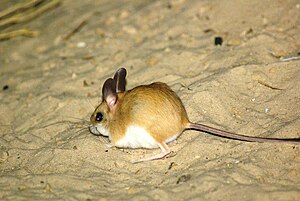Dark bouncy mouse
| Dark bouncy mouse | ||||||||||||
|---|---|---|---|---|---|---|---|---|---|---|---|---|

Dark bouncy mouse ( Notomys fuscus ) |
||||||||||||
| Systematics | ||||||||||||
|
||||||||||||
| Scientific name | ||||||||||||
| Notomys fuscus | ||||||||||||
| ( Jones , 1925) |
The dark bouncy mouse ( Notomys fuscus ) is a rodent belonging to the genus of the Australian bouncy mice ( Notomys ).
description
The head-trunk length is 80 to 115 mm. The tail length reaches between 120 and 155 mm. The rear foot length is 35 to 40 mm and the ear length 24 to 28 mm. The weight is between 20 and 50 g. The light orange to gray back contrasts sharply with the white underside. Both sexes have a throat pouch. The females have four belly teats.
distribution
Their distribution area extends over southwest Queensland ( Pelican Waterhole ), northeastern South Australia (southern Strzeleki Desert and Cobblers Desert and Carraweena , Montecollina Bore and Quinyambie Station ) to western New South Wales .
Way of life
This species is a resident of the sand dunes . She digs a structure about one meter below the surface that can be up to five meters long. Up to five animals can then live in two neighboring burrows. It searches for food at night and feeds on seeds, leaves and occasionally insects. Little is known about breeding behavior in the wild, but it is known from animals bred in human care that the gestation period was 38 to 41 days and one to five young were raised. The females become sexually mature after 70 days.
Danger
The Dark Hüpfmaus is a fairly rare type. From the IUCN it is as vulnerable (endangered) and the Nature Conservation Act is (Nature Conservation Act of Queensland) them as endangered (high risk) listed. It has become extinct in much of South Australia and the southwestern Northern Territory . The reasons for the decline have not yet been fully explored. The main factors, however, are presumably introduced foxes , feral domestic cats and the changes in their habitat due to grazing cattle and rabbits .
literature
- Peter Menkhorst: A Field Guide to the Mammals of Australia. Illustrated by Frank Knight. Oxford University Press, South Melbourne et al. 2001, ISBN 0-19-550870-X .
- Ronald Strahan (Ed.): The Mammals of Australia. The National Photographic Index of Australian Wildlife. Revised edition. New Holland, Sydney 1998, ISBN 1-87633-401-0 .
Web links
- Queensland Parks and Wildlife Serve - Dusky Hopping Mouse ( April 27, 2009 memento in the Internet Archive )
- Notomys fuscus in the endangered Red List species the IUCN 2006 Posted by: J. Baille, 1996. Retrieved on 1 November of 2006.